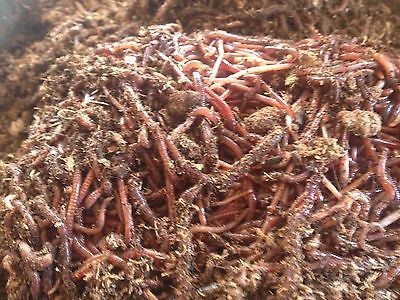Composting-perfect red wigglers: Use them to reduce waste
Using Red Wigglers for Effective Organic Waste Disposal
These worms not just improve waste decay yet likewise produce useful worm castings, which can significantly boost soil wellness. Comprehending the nuances of establishing up a successful worm container and keeping an ideal habitat is vital for maximizing their benefits.
Advantages of Utilizing Red Wigglers
Among one of the most compelling advantages of utilizing red wigglers for natural waste disposal is their impressive effectiveness in composting. These worms, clinically called Eisenia fetida, are particularly adjusted for damaging down natural products, allowing them to process waste as much as twice their body weight each day. This quick decay not just accelerates the composting process yet additionally produces nutrient-rich worm castings that dramatically boost soil top quality.
Additionally, red wigglers contribute to a reduction in garbage dump waste. By diverting organic materials from garbage dumps, they help minimize methane exhausts-- a potent greenhouse gas. This eco-friendly advantage is crucial in the battle versus climate adjustment.
Furthermore, red wigglers are low-maintenance and can thrive in different environments, making them easily accessible for both amateur and skilled composters. Their ability to recreate rapidly makes certain a steady population, helping with recurring waste handling.
Establishing Your Worm Bin
Creating an efficient worm bin is crucial for taking full advantage of the advantages of composting with red wigglers. The initial step is selecting a suitable container. A bin made from plastic or wood, with an ability of 10 to 20 gallons, is optimal. Make sure the container has appropriate drainage holes to avoid excess moisture, as red wigglers prosper in a damp however not soaked setting.
(red wiggler worms near me)Next, prepare the bedding product, which works as the worms' environment and food source. Shredded paper, cardboard, and coconut coir are exceptional options. Aim for a bed linens depth of around 4 to 6 inches. The bin ought to be placed in a dark, temperature-controlled location, preferably between 55 ° F and 77 ° F, to preserve worm activity.
As soon as the bin is set up, present the red wigglers, permitting them to adjust to their brand-new setting. A properly maintained container will not only support the health and wellness of the worms yet likewise assist in reliable decay of organic waste.
(red wigglers for sale)
What to Feed Red Wigglers
An understanding of the suitable diet for red wigglers is crucial for maintaining a healthy worm populace and maximizing composting performance. Red wigglers flourish on a diverse diet plan that mostly contains natural materials. Suitable food sources consist of veggie scraps, fruit peels, coffee premises, eggshells, and shredded paper. These items not just offer essential nutrients however likewise add to the wetness balance within the worm bin.
It is crucial to avoid specific foods that can damage the worm population. Red wigglers ought to not be fed meat, milk products, oily foods, browse around here or refined products, as these can attract parasites and develop unpleasant smells. red wigglers. Furthermore, citrus fruits and hot foods must be decreased, as their level of acidity can be harmful to worms
To advertise ideal food digestion, food needs to be cut right into smaller pieces, facilitating quicker malfunction and intake. Presenting food in moderation is additionally vital; overfeeding can bring about anaerobic problems and attract unwanted parasites. Keeping an eye on the worm container for food usage prices will certainly help make sure that red wigglers are receiving an ample diet plan while keeping an effective composting atmosphere. Appropriate feeding methods are vital for fostering a growing ecological community within the worm bin.
Maintaining Your Worm Environment
A well-kept worm environment is essential for the health and wellness and performance of red wigglers. To guarantee ideal conditions, it is important to keep an eye on temperature, moisture, and aeration within the worm bin (red wigglers).
Moisture levels ought to be maintained constant; the bed linens ought to perspire but not soaked. A great policy of thumb is to keep dampness at about 70% to 80%. If the bedding becomes also damp, it can cause anaerobic conditions that are hazardous to the worms. Adding completely dry carbon-rich materials, such as shredded paper or cardboard, can assist soak up excess moisture.

Utilizing Worm Castings in Horticulture
Rich in nutrients and advantageous microbes, worm castings function as an exceptional natural plant food for horticulture. Generated through the digestion processes of red wigglers, these spreadings contain an array of necessary nutrients, including nitrogen, phosphorus, and potassium, which advertise durable plant development. Unlike synthetic plant foods, worm castings use a slow-release mechanism, guaranteeing that nutrients are offered to plants over an extensive period, consequently lowering the danger of nutrient leaching and soil exhaustion.
Along with nutrition web content, worm castings boost soil framework and oygenation, boosting moisture retention and water drainage. The microbial life present in worm castings assists to suppress pathogens and advertises a healthy and balanced soil ecological community, additional profiting plant health and wellness. When incorporated into the dirt or utilized as a leading dressing, worm castings can significantly improve seed germination prices, origin advancement, and overall plant vitality.
For optimum outcomes, garden enthusiasts should use worm spreadings at a rate of 1-2 inches per square foot, mixing them into the soil or incorporating them right into potting mixes. Overall, using worm castings is an environment-friendly technique to enhancing soil fertility and making certain flourishing garden atmospheres.
Conclusion
